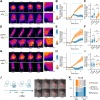Optogenetic control of a GEF of RhoA uncovers a signaling switch from retraction to protrusion
- PMID: 40421714
- PMCID: PMC12113259
- DOI: 10.7554/eLife.93180
Optogenetic control of a GEF of RhoA uncovers a signaling switch from retraction to protrusion
Abstract
The ability of a single protein to trigger different functions is an assumed key feature of cell signaling, yet there are very few examples demonstrating it. Here, using an optogenetic tool to control membrane localization of RhoA nucleotide exchange factors (GEFs), we present a case where the same protein can trigger both protrusion and retraction when recruited to the plasma membrane, polarizing the cell in two opposite directions. We show that the basal concentration of the GEF prior to activation predicts the resulting phenotype. A low concentration leads to retraction, whereas a high concentration triggers protrusion. This unexpected protruding behavior arises from the simultaneous activation of Cdc42 by the GEF and sequestration of active RhoA by the GEF PH domain at high concentrations. We propose a minimal model that recapitulates the phenotypic switch, and we use its predictions to control the two phenotypes within selected cells by adjusting the frequency of light pulses. Our work exemplifies a unique case of control of antagonist phenotypes by a single protein that switches its function based on its concentration or dynamics of activity. It raises numerous open questions about the link between signaling protein and function, particularly in contexts where proteins are highly overexpressed, as often observed in cancer.
Keywords: cell biology; cell migration; human; optogenetics; signaling.
© 2023, de Seze et al.
Conflict of interest statement
Jd, MB, BB, MC No competing interests declared
Figures













Update of
- doi: 10.1101/2023.09.07.556666
- doi: 10.7554/eLife.93180.1
- doi: 10.7554/eLife.93180.2
- doi: 10.7554/eLife.93180.3
Similar articles
-
The guanine nucleotide exchange factor Tiam1: a Janus-faced molecule in cellular signaling.Cell Signal. 2014 Mar;26(3):483-91. doi: 10.1016/j.cellsig.2013.11.034. Epub 2013 Dec 2. Cell Signal. 2014. PMID: 24308970 Review.
-
Guanine nucleotide exchange factor-H1 regulates cell migration via localized activation of RhoA at the leading edge.Mol Biol Cell. 2009 Sep;20(18):4070-82. doi: 10.1091/mbc.e09-01-0041. Epub 2009 Jul 22. Mol Biol Cell. 2009. PMID: 19625450 Free PMC article.
-
Characterization of p190RhoGEF, a RhoA-specific guanine nucleotide exchange factor that interacts with microtubules.J Biol Chem. 2001 Feb 16;276(7):4948-56. doi: 10.1074/jbc.M003839200. Epub 2000 Oct 31. J Biol Chem. 2001. PMID: 11058585
-
Diverse roles of guanine nucleotide exchange factors in regulating collective cell migration.J Cell Biol. 2017 Jun 5;216(6):1543-1556. doi: 10.1083/jcb.201609095. Epub 2017 May 16. J Cell Biol. 2017. PMID: 28512143 Free PMC article.
-
Regulation and functions of the RhoA regulatory guanine nucleotide exchange factor GEF-H1.Small GTPases. 2021 Sep-Nov;12(5-6):358-371. doi: 10.1080/21541248.2020.1840889. Epub 2020 Oct 30. Small GTPases. 2021. PMID: 33126816 Free PMC article. Review.
References
MeSH terms
Substances
Grants and funding
LinkOut - more resources
Full Text Sources
Miscellaneous

